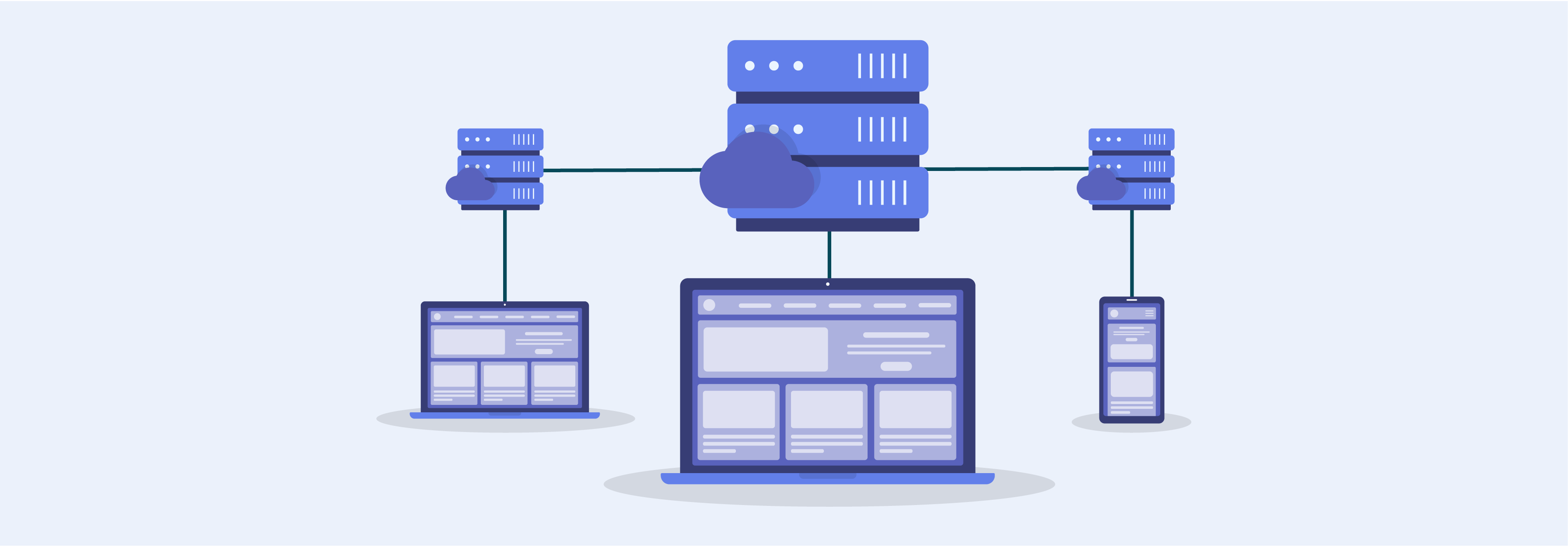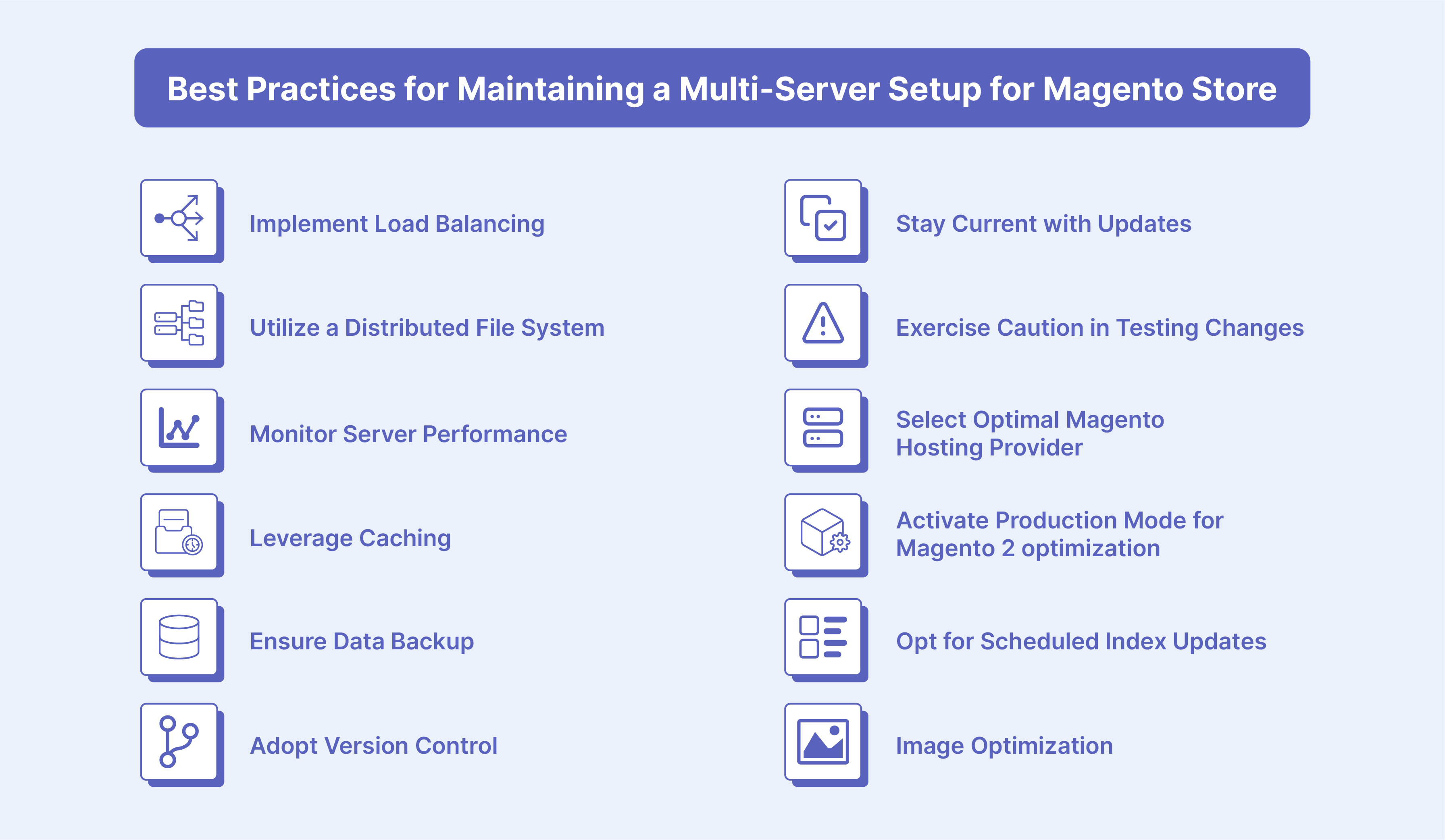
Optimize Magento Performance With Multi-server Hosting In Magento 2
Boosting Magento performance with multi-server hosting allows you to distribute the workload across multiple servers. This approach effectively manages high traffic loads, resulting in improved speed and reliability. This guide will outline the benefits of multi-server hosting for optimizing Magento performance. It will also highlight the best practices and the necessity of a multi-server web environment for Magento.
-
Leveraging Amazon Web Services (AWS) for a Multi-Server Configuration for Performance Optimization
-
Benefits of a Multi-Server Web Environment for Magento 2 Performance on AWS
-
Best Practices for Maintaining a Multi-Server Setup for Magento Store
Key Takeaways
-
Explore how multi-server setups optimize Magento tasks for enhanced performance.
-
Discover AWS's role in providing scalability and Magento security for Magento's multi-server configuration.
-
Dive into the critical roles of Magento load balancers, web servers, NFS servers, database servers, and caching servers.
-
Learn how even traffic distribution across servers improves response times and performance.
-
Explore redundancy and backup systems for uninterrupted service and data protection.
-
Learn key practices like load balancing, distributed file systems, monitoring, and cautious testing.
What is a multi-server web environment?

A multi-server web environment involves the utilization of multiple servers to operate a web application. This configuration is commonly employed to manage heavy website traffic, improving performance and reliability.
These systems comprise more than one server, collectively servicing incoming customer requests. Multi-server models can incorporate either identical or diverse server types.
Who needs a Multi-server Web Environment in Magento 2?
Magento 2 is a resource-intensive software demanding substantial processing power and memory for optimal operation. Businesses benefit most from a multi-server system, particularly those with significant online orders through their websites.
When service demand reaches a certain threshold, adding more servers becomes necessary. This configuration enhances performance, uptime, security, and resource allocation efficiency. Diverting resources across multiple servers offers several advantages, including operating varying operating systems on each server.
Leveraging Amazon Web Services (AWS) for a Multi-Server Configuration for Performance Optimization
Amazon Web Services (AWS) offers a scalable and dependable infrastructure perfectly suited to the requirements of a multi-server setup. AWS also provides an array of services tailored to enhance the performance and security of Magento.
In a typical multi-server setup for Magento on AWS, the following components play crucial roles:
1. Load Balancer

A load balancer, whether software or hardware, plays a pivotal role by evenly distributing network traffic across multiple servers. Its primary function is to ensure that each server within the setup receives an equal share of the workload. This distribution results in heightened performance and reliability.
2. Web Servers

Web servers play a pivotal role in a multi-server setup by hosting web applications and facilitating web content delivery to end-users. These servers are responsible for handling incoming HTTP requests and ensuring the seamless presentation of web pages to visitors.
The performance and responsiveness of web servers directly impact the user experience. It makes them a critical component in Magento's efficient multi-server web environment.
3. NFS Server

Network File System (NFS) servers are instrumental in a multi-server configuration, facilitating the sharing of files and resources among servers. This collaborative capability streamlines data exchange and resource access across the infrastructure.
It ensures that data and resources are readily available to support the various components of the Magento application.
4. Database Server

The database server assumes a central role in a multi-server web environment for Magento. It serves as the repository for storing and managing all data related to the web application. It encompasses critical components such as product information, customer data, and transaction records.
The database server's performance and reliability directly impact the Magento site's overall functionality and responsiveness. Ensuring the efficient operation of the database server is important to delivering a seamless and satisfying user experience.
5. Caching Server (Varnish Cache, ElastiCache)

A caching server, such as Magento Varnish Cache or AWS ElastiCache, is critical for optimizing performance. This type of server stores frequently accessed data or content in its memory or storage.
It also allows for faster data retrieval, as cached data can be readily accessed without fetching it from the source each time a request is made. Employing a caching server within a multi-server setup for Magento can significantly enhance the application's overall performance.
Benefits of a Multi-Server Web Environment for Magento 2 Performance on AWS
Using multiple servers with Magento offers several benefits to businesses seeking enhanced performance, scalability, and reliability for their online stores.
Here are the key advantages of utilizing multiple servers with Magento:
1. Improved Performance: Load Distribution

By leveraging multiple servers, website traffic can be evenly distributed across various servers. This practice prevents the overburdening of a single server and results in faster response times for users.
The specialization of different servers for tasks such as database queries, web requests, and media storage also optimizes resource utilization, ultimately enhancing overall performance.
2. Scalability: Vertical and Horizontal Scaling

Multiple servers offer the flexibility of vertical scaling (upgrading server resources like RAM and CPU) and horizontal scaling (adding more servers) in response to demand fluctuations. This adaptability ensures your website can effectively handle increased traffic during promotional campaigns or sales events.
3. Enhanced Redundancy and Reliability

-
Redundancy: In the event of one server's failure, others can seamlessly take over, minimizing downtime and ensuring uninterrupted service for your customers.
-
Backup and Disaster Recovery: Multiple servers facilitate efficient Magento backup systems and disaster recovery plans. Regular backups can be securely stored on separate servers, reducing the risk of data loss.
4. Global Content Delivery: Content Delivery Networks (CDNs)

Integrating multiple servers across diverse geographical locations and incorporating CDNs in Magento ensures expedited content delivery to users worldwide. CDNs cache static content and serve it from servers closer to users. It prevents latency and enhances website speed.
5. Security: Isolation of Services

Isolating web servers, databases, and application servers on distinct machines increases security. Compromising one server does not necessarily include access to all services.
Moreover, multiple servers enable swift responses to security threats by facilitating the application of Magento security patches and updates without disrupting the entire system.
6. Customization and Optimization

-
Tailored Configurations: Different servers can be optimized for specific tasks. For instance, a dedicated database server can be finely tuned for database operations. It enhances the efficiency of tasks related to databases.
-
Custom Resource Allocation: Resources like CPU, memory, and storage can be allocated based on specific server requirements. It optimizes performance for each task.
7. Cost Savings through Efficient Resource Utilization on Magento Website

Efficient resource utilization, made possible using multiple servers, is a cost-effective Magento solution. This efficiency ensures that resources are allocated judiciously. It minimizes wastage and reduces operational expenses.
Best Practices for Maintaining a Multi-Server Setup for Magento Store

1. Implement Load Balancing
Employ a Magento load balancer to distribute incoming traffic across multiple servers evenly. It prevents any server from becoming overwhelmed, resulting in enhanced system performance and user experience.
2. Utilize a Distributed File System
Adopt a distributed file system to facilitate seamless file sharing and resource access among servers. It promotes efficient collaboration and data exchange within the multi-server environment.
3. Monitor Server Performance
Regularly monitor the performance of individual servers to detect issues or bottlenecks promptly. This proactive approach allows for timely intervention and optimization.
4. Leverage Caching
Implement caching mechanisms to store frequently accessed data or content, reducing the need to retrieve it from the source with each request. This practice significantly improves response times and overall system performance.
5. Ensure Data Backup
Maintain a reliable data backup strategy to safeguard critical information. Regular backups, stored securely on separate servers, prevent the risk of data loss in case of unforeseen events.
6. Adopt Version Control
Utilize version control systems to manage code changes and collaborate effectively among development teams. It helps maintain code integrity and facilitates seamless updates.
7. Stay Current with Updates
Keep your system and software components up-to-date by promptly applying security patches and updates. It is vital in addressing vulnerabilities and ensuring system security.
8. Exercise Caution in Testing Changes
Before implementing changes in the production environment, conduct thorough testing in a controlled, non-production environment or a Magento test server. This practice helps identify and rectify issues before they impact the live system.
9. Select Optimal Magento Hosting Provider
Choosing the right Magento hosting provider for your Magento store is crucial. Opt for VPS-based plans for enhanced power and control, ensuring a seamless online shopping experience. Additionally, seek a hosting provider skilled in performance tuning to consolidate CSS and JavaScript files effectively.
10. Activate Production Mode for Magento 2 optimization
Enabling production mode, particularly in a multi-server setup, ensures optimal performance for your online store. Among Magento's three modes, production is the preferred choice for live websites as it is optimized to accommodate high visitor volumes smoothly.
11. Opt for Scheduled Index Updates
In a multi-server setup, it's advisable to configure index management to "Update on Schedule." It ensures that your Magento store's indexes are automatically refreshed whenever changes occur, such as adding new products.
12. Image Optimization
Boost your Magento website's speed by resizing images appropriately. Large images can slow down your site, so use the correct sizes. Employ tools to reduce image size without compromising quality in Magento UX. It results in faster page loading times, providing customers with a smoother and more satisfying shopping experience.
FAQs
1. How to manage static files in a Multi-Server setup for a Magento developer?
For consistency, manage static files in a multi-server Magento setup with a central storage system like NFS. Employ a CDN to enhance site speed by efficiently caching and delivering static files.
2. How can Varnish Cache be integrated with a Multi-Server Magento Environment?
Integrate Magento Varnish Cache in a Multi-Server Magento Environment by installing it on separate servers to cache and serve content. Configure Magento servers to use Varnish as a reverse proxy for incoming traffic.
3. What are the key components of a multi-server setup for optimizing Magento performance?
A multi-server configuration for Magento ecommerce typically involves essential components like load balancers, web servers, and database servers. It also includes caching servers (such as Varnish Cache or AWS ElastiCache) and NFS servers. These components collectively manage website traffic, data storage, content delivery, and resource sharing, ensuring improved website performance.
4. How does a multi-server web environment benefit e-commerce businesses aiming to grow in diverse regions?
Running a multi-server setup remains essential for an e-commerce business aiming to grow across regions. It optimizes website performance by distributing traffic effectively. The diverse servers cater to varying demands across regions, ensuring consistent and reliable service.
5. Why does an e-commerce website running Magento require a multi-server setup?
An e-commerce website on Magento often experiences high traffic demands, especially during peak periods or sales events. A multi-server setup becomes crucial to handle these fluctuations efficiently. It enables the website to scale resources vertically and horizontally, maintaining optimal performance during increased traffic.
6. How can I improve my Magento store's performance and speed?
To optimize your Magento store performance, consider upgrading to the latest Magento version and implementing efficient image optimization techniques. Also, regularly monitor your Magento database. Addressing these aspects can mitigate slow Magento issues and prevent performance degradation.
7. What steps can be taken to address performance degradation in Magento?
To combat performance degradation in Magento, optimize your Magento store by enhancing page speed and overall performance. Undertake measures such as upgrading to the latest Magento version, fine-tuning Magento database configurations, and implementing image optimization strategies. Regularly review and optimize Magento admin settings to ensure a smoother and faster shopping experience for users.
Summary
Boosting Magento site performance with multi-server hosting involves distributing the workload across multiple servers. This approach effectively manages high traffic loads, improving speed, reliability, and overall website performance.
This guide discussed the advantages of a multi-server web environment in optimizing Magento performance. It emphasized the utilization of Amazon Web Services (AWS) for multi-server setups. It focused on key components like load balancers, web servers, NFS servers, database servers, and caching servers.
Want a managed multi-server setup for your Magento store? Explore more about enhancing your website's performance through efficient Magento multi-server hosting.



